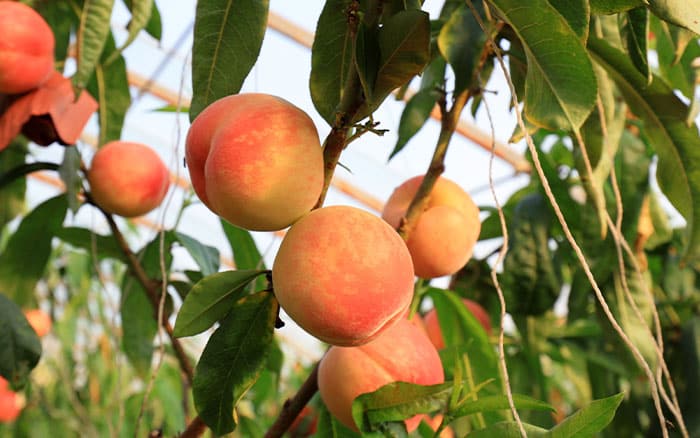There is nothing quite like the smell and taste of freshly picked, ripe peaches and nectarines. Although they both like a warm, sunny climate, it is possible to grow them well in the UK. Especially if you have a sunny south facing wall or fence that they can be grown up against, or failing that, a sunny greenhouse or conservatory.
Growing in pots
If you are going to grow in a greenhouse, it’s much better to plant the trees in containers rather than directly into the ground.
They seem to stay healthier when grown that way as they can be moved outside during the summer. This helps to reduce the build-up of pests on the leaves of the trees.
So, if growing in containers, keep your tree outside from mid-summer until mid-winter.
Ensure you bring the containers into the greenhouse by mid-January at the latest because if they’re left out any longer, the tree leaves could succumb to a bout of leaf curl. Leaf curl can reduce the health of the tree, as well as fruit yield.

Pollinating peaches and nectarines
When growing peaches and nectarines, they both tend to flower early in the year. So, if many insects are not out and about when the trees begin to flower, have a go at hand pollinating the flowers yourself to get a good crop of fruit.
This is a very easy process and can be done using the following steps.
Take a small paintbrush and brush it gently across the stamen of one flower to gather the pollen. Then, brush the pollen onto the pistil of the next flower and so on, working your way across all the accessible blossom on the tree.

Fruit thinning
It’s incredibly exciting watching the young fruit develop. They look so great that it can be tempting to leave them all on the tree.
However, it really does pay dividends to remove some of the developing fruit. Even though it may be hard to bring yourself to do.
Leaving too many fruits on the tree means they won’t all ripen. Remove fruit so that the remaining crop are about a hand width apart from each other. If you do this you should end up with fruit that are not only larger, but also much more likely to ripen.

Looking after the trees
Ventilation
Whether you’re growing the trees in containers in the greenhouse or planted in the garden, it’s very important to allow air to circulate around the trees. This care will help to decrease the likelihood of them succumbing to diseases.
Keeping windows and doors open in a greenhouse is important to cool down the temperature. Fruit trees do not need excessive heat to grow and fruit well.
Watering and feeding
Also, water the trees regularly during the growing season.
To ensure they get enough nutrition add a small amount of a balanced liquid feed designed for fruit tree to the watering can each time you water. When the trees are in flower and fruit developing, change the feed to a high potassium one.
Avoid peach leaf curl
Peach leaf curl is a serious fungal disease that badly affects peaches and nectarines. The time to look out for it is around mid-January when the new leaves start to appear.
The leaves on trees with this disease will curl up and develop large reddish blisters before falling prematurely. The flowers are distorted when they appear and often drop without forming fruit.
The fungus can weaken the tree so much that it will literally starve to death within two or three years if untreated. The good news is that there are ways to avoid peach leaf curl.
One way is to grow the tree in containers in a greenhouse or conservatory. The other is to choose a variety that has a high degree of resistance to the fungus such as Peach ‘Peregrine’.
Whether or not your tree has shown signs of peach leaf curl always rake up fallen leaves from around the tree, especially during the winter months.
Give the trees regular watering. When doing this, water the base of the tree rather than on the leaves as this will help reduce stress on the tree. A full watering can of water given twice a week, especially during the summer months will also help.
If your tree has peach leaf curl, thin the fruit to enable the tree to store enough energy to make it through the winter.
The other way to avoid peach leaf curl is to cover your tree from late January until mid-May to stop new leaves becoming wet. Do this by attaching clear plastic to a simple wood frame to protect the tree from the fungal spores. It’s important to ensure the plastic doesn’t touch the leaves and so tacking plastic to a wooden frame should do the trick.
The plastic covered frame will also protect the tree blossom from damaging spring frosts.


Leave A Comment